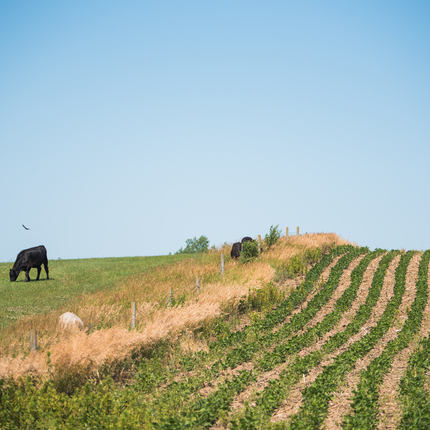Kate Hansen contributed to this blog.
Since 1973, the Center for Rural Affairs has advocated for conservation as a valuable tool for farmers and ranchers to establish and grow their operations, including supporting programs such as the Environmental Quality Incentives Program (EQIP) and the Conservation Stewardship Program (CSP).
With passage of the farm bill in December 2018, the Center for Rural Affairs’ attention turns to the U.S. Department of Agriculture (USDA), which is responsible for enacting the farm bill.
USDA will soon release rules for its major conservation programs, including EQIP and CSP. The rules will serve as a guide for how the programs will work over the next few years.
Once the rules are released, the Center for Rural Affairs will offer recommendations to USDA to ensure the changes improve farmers and ranchers’ ability to participate and enhance conservation on their operations.
EQIP and CSP are vital working lands programs that offer farmers and ranchers a path to increasing and enhancing conservation on their operations. They serve unique functions: both offer financial assistance to farmers and ranchers to implement individual conservation practices, but EQIP offers support for individual practices, while CSP offers support for a planned set of practices. CSP participants are also required to demonstrate their existing conservation practices in order to enroll, while EQIP participants are not.
Below are a few of the Center’s recommendations to make EQIP more accessible and streamlined as well as how it can better work with CSP.
Streamline enrollment in CSP and EQIP while maintaining their separate functions.
The 2018 farm bill requires the Natural Resource Conservation Service (NRCS) to streamline enrollment in both EQIP and CSP. We ask that NRCS develop clear messaging about the differences between the two programs, and coordinate between programs where logical, such as with ranking tools, applications forms, and sign-up deadlines where possible. Finally, NRCS may consider changes to streamline enrollment in CSP.
Ensure the new EQIP incentive contracts offer a pathway to move into CSP.
The new farm bill creates a new opportunity titled “incentive contract” under EQIP. We recommend the new incentive contracts provide an on-ramp to help farmers and ranchers become eligible for CSP, including allowing EQIP incentive contracts to end early once a farmer or rancher meets the stewardship threshold for two resource concerns on their operation.
Increase outreach and promotion of targeted conservation funding for beginning and socially-disadvantaged producers.
The 2018 farm bill extended through 2023 the requirement that 5 percent of both CSP and EQIP funds be used to assist beginning farmers and ranchers, and an additional 5 percent of each be used to assist socially-disadvantaged farmers and ranchers. We support these set-asides, and encourage NRCS to collaborate with other expert USDA staff to conduct targeted outreach about the availability of this opportunity and these funds. We also ask that NRCS release annual information by state regarding participation in CSP and EQIP by these targeted groups.
Clarify and promote advance EQIP payment option for beginning and socially-disadvantaged producers.
EQIP is a financial assistance program, and typically under an EQIP contract, NRCS reimburses costs for conservation practices after the money has been spent. This can create cash flow challenges, especially for beginning, socially-disadvantaged, and others who do not have capital reserves to rely on. The 2014 farm bill created an option where beginning, socially-disadvantaged, and veteran producers can receive advance payments of up to 50 percent of the conservation practice cost under EQIP and the 2018 farm bill strengthened these provisions. We encourage NRCS to develop and release outreach materials explaining this option, to work with relevant USDA staff on outreach efforts, to release training for staff in local offices to ensure they are up-to-date on the new requirements, and to release relevant data.
Hold conservation program sign-ups early in the fiscal year and before planting season, and widely advertise.
Sign-ups for federal conservation programs happen at different points in the year. Our first recommendation is that USDA endeavor to standardize conservation program deadlines across states and from year to year. In particular, we urge USDA to standardize EQIP sign-up dates across states. Many of the media outlets that support outreach on conservation programs work across state lines, and farmers and ranchers have businesses and relationships that cross state lines. Standardizing sign-up dates by state and by year would vastly help with outreach.
You can read more of our recommendations in our paper "Conservation for Rural Communities: Center for Rural Affairs Farm Bill Implementation Recommendations." Watch our blog for additional implementation recommendations as well.
Have you had an EQIP contract? Do any of these recommendations resonate with you? Do you have your own recommendations about accessibility in EQIP, or CSP? We invite you to write a comment to USDA in the coming months. Farmers’ and ranchers’ voices are especially important to hear in these decisions. If you would like to learn more about writing a comment to USDA, please contact [email protected], [email protected], or give us a call at 515.215.1294.





